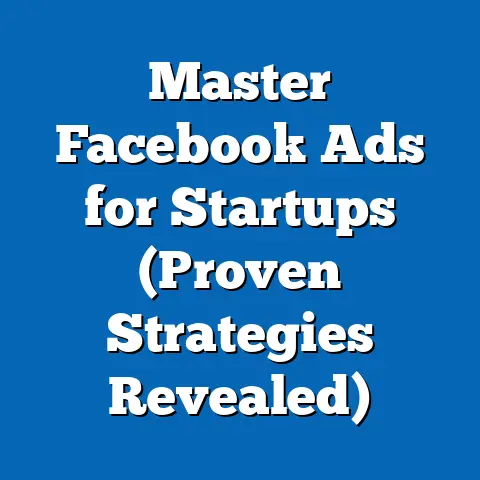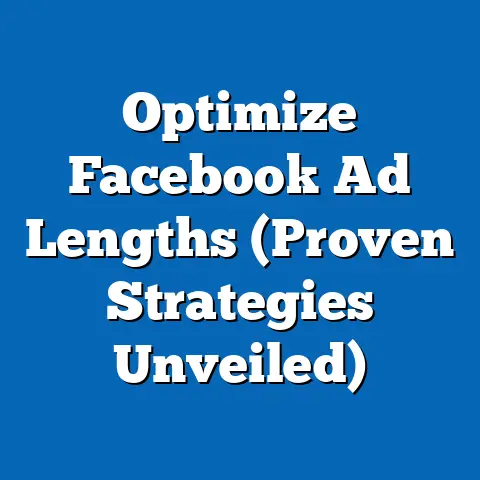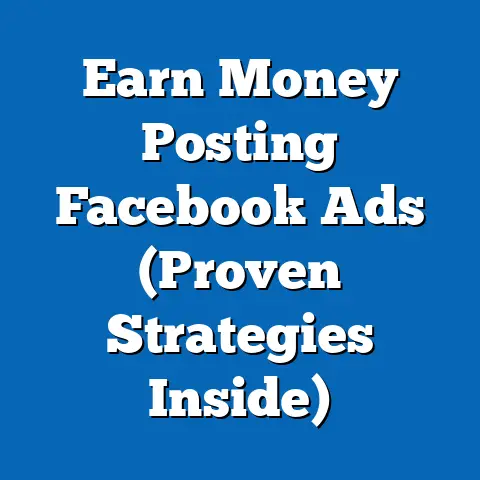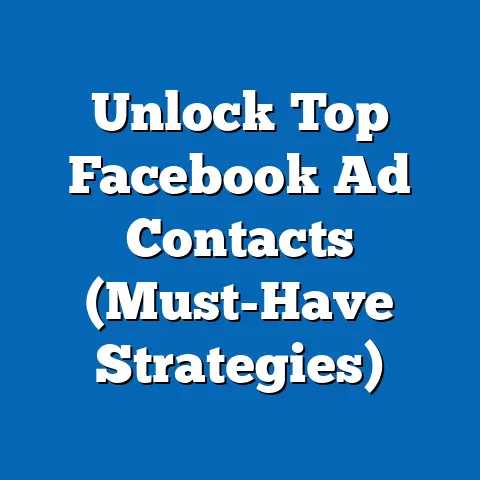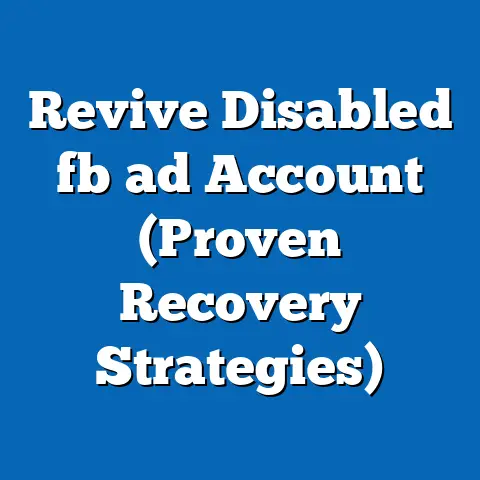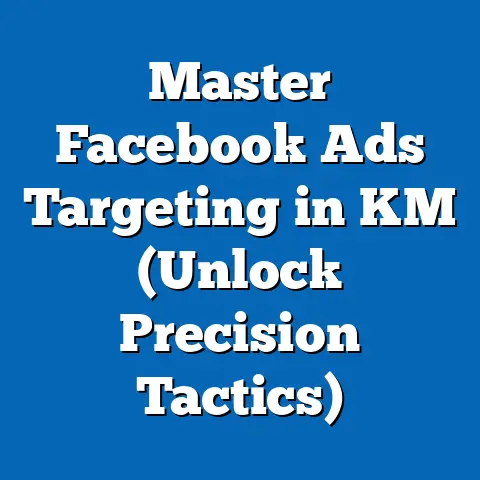Maximize Digital Ad Spend on Facebook (Proven Strategies)
Understanding Facebook’s Advertising Ecosystem
Think of Facebook’s advertising ecosystem as a vast, intricate city. To navigate it effectively, you need to understand its neighborhoods (ad formats) and transportation systems (placements).
Ad Formats: Choose Your Vehicle Wisely
Facebook offers a diverse range of ad formats, each designed for specific purposes. I’ve experimented with them all, and here’s my take:
- Image Ads: The simplest format, ideal for quick, attention-grabbing messages. I’ve found they work best for brand awareness or showcasing a single product.
- Video Ads: Highly engaging, perfect for storytelling and demonstrating product features. Short, impactful videos tend to perform best. I once created a series of short video ads showcasing customer testimonials, and it significantly boosted our conversion rates.
- Carousel Ads: Allows you to showcase multiple products or features in a single ad. Great for e-commerce or highlighting different aspects of a service. I used a carousel ad to showcase different vacation packages, and it drove a significant increase in bookings.
- Slideshow Ads: Combines images and text to create a video-like experience. A cost-effective alternative to video ads, especially for businesses with limited resources.
- Collection Ads: Primarily for mobile devices, allowing users to browse and purchase products directly from the ad. Ideal for e-commerce businesses with a large product catalog.
The key is to choose the ad format that best aligns with your campaign objectives and target audience.
Ad Placements: Location, Location, Location
Where your ad appears on Facebook significantly impacts its performance. Here are the main placement options:
- Facebook News Feed: The most common placement, offering high visibility and engagement.
- Instagram Feed: Leverages Facebook’s Instagram platform, ideal for visually appealing products and younger audiences.
- Facebook Stories & Instagram Stories: Immersive, full-screen ads that disappear after 24 hours. Great for capturing attention and driving immediate action.
- Facebook Marketplace: Allows you to reach users actively searching for products and services.
- Facebook Right Column: A less prominent placement, but can be effective for retargeting and brand awareness.
- Audience Network: Extends your reach beyond Facebook to a network of mobile apps and websites.
I’ve learned that testing different placements is crucial. What works for one campaign might not work for another. Use Facebook’s automatic placements to start, then analyze the data and optimize accordingly.
Takeaway: Understanding the nuances of Facebook’s ad formats and placements is the foundation of a successful campaign. Experiment, analyze, and adapt to find what works best for your business.
Defining Clear Objectives
Before you even think about crafting an ad, you need to answer one fundamental question: What do you want to achieve? Setting clear, measurable objectives is not just a best practice; it’s the compass that guides your entire Facebook advertising journey.
Marketing Funnel Alignment: From Awareness to Conversion
Think of your marketing efforts as a funnel. At the top, you’re casting a wide net to create awareness. As you move down, you’re narrowing your focus, nurturing interest, and ultimately driving conversions. Your Facebook ad objectives should align with each stage of this funnel.
- Awareness: If your goal is to increase brand recognition, objectives like “Brand Awareness” or “Reach” are ideal. These aim to show your ad to as many people as possible within your target audience.
- Consideration: When you want to generate interest and engagement, objectives like “Traffic,” “Engagement,” “App Installs,” “Video Views,” or “Lead Generation” are more suitable. These encourage users to interact with your content, visit your website, or provide their contact information.
- Conversion: If your ultimate goal is to drive sales or specific actions, objectives like “Conversions,” “Catalog Sales,” or “Store Traffic” are the way to go. These focus on getting users to complete a purchase, sign up for a service, or visit your physical store.
I remember working with a client who was solely focused on driving sales. They were running conversion ads to a cold audience with no prior exposure to their brand. Unsurprisingly, the results were dismal. Once we shifted the strategy to first focus on building awareness and generating leads, the conversion campaigns started to perform much better.
SMART Goals: The Gold Standard
Vague objectives are a recipe for failure. That’s where SMART goals come in. They provide a framework for setting objectives that are:
- Specific: Clearly defined, leaving no room for ambiguity.
- Measurable: Quantifiable, allowing you to track progress and assess success.
- Achievable: Realistic and attainable, considering your resources and constraints.
- Relevant: Aligned with your overall business goals and marketing strategy.
- Time-bound: With a defined timeframe for completion.
Examples of SMART Goals for Facebook Advertising:
- Awareness: “Increase brand awareness by 20% among women aged 25-34 in the US within the next quarter, as measured by Facebook Brand Lift studies.”
- Consideration: “Drive 500 new email sign-ups through a lead generation campaign targeting small business owners interested in marketing automation within the next month.”
- Conversion: “Increase online sales of product X by 15% among existing customers aged 35-44 in the EU within the next two months, as measured by Facebook pixel conversions.”
Takeaway: Don’t skip this crucial step! Define your objectives clearly, align them with your marketing funnel, and make them SMART. This will provide a clear roadmap for your Facebook advertising efforts and ensure you’re measuring the right metrics.
Audience Targeting Techniques
Imagine trying to sell snow shovels in the Sahara Desert. Sounds ridiculous, right? That’s what happens when you don’t nail your audience targeting on Facebook. It’s like throwing money into a black hole. Mastering audience targeting is the key to reaching the right people, with the right message, at the right time, and ultimately maximizing your ad spend.
The Power of Segmentation
Segmentation is the process of dividing your target market into smaller, more homogenous groups based on shared characteristics. This allows you to tailor your ads to resonate with specific segments, increasing engagement and conversion rates.
Think of it like this: You wouldn’t use the same language and imagery to target teenagers as you would senior citizens. Segmentation allows you to create different ads for each group, addressing their specific needs and interests.
Facebook’s Targeting Arsenal
Facebook offers a powerful arsenal of targeting options:
- Demographic Targeting: Allows you to target users based on age, gender, education, relationship status, job title, and more. This is a good starting point, but don’t rely on it exclusively.
- Geographic Targeting: Allows you to target users based on their location, from country to city to zip code. Essential for local businesses or campaigns targeting specific regions.
- Interest-Based Targeting: Allows you to target users based on their interests, hobbies, and pages they’ve liked. This is where you can really hone in on your ideal customer. For example, if you’re selling fitness equipment, you can target people interested in “weightlifting,” “yoga,” or “healthy eating.”
- Behavioral Targeting: Allows you to target users based on their online behavior, such as purchase history, device usage, and travel habits. This can be incredibly powerful for reaching users who are likely to be interested in your products or services.
Custom Audiences: Your Secret Weapon
Custom Audiences allow you to target users based on your own data sources:
- Customer List: Upload a list of your existing customers (email addresses, phone numbers) to target them with specific ads or exclude them from certain campaigns.
- Website Traffic: Use the Facebook pixel to track visitors to your website and retarget them with relevant ads. This is incredibly effective for reminding users about products they viewed but didn’t purchase.
- App Activity: Target users based on their activity within your mobile app.
- Engagement: Target users who have interacted with your Facebook page or ads in the past.
I had a client who was struggling to generate repeat purchases. We created a Custom Audience of users who had purchased from them in the past year and targeted them with a special discount code. The result? A significant boost in repeat sales.
Lookalike Audiences: Expand Your Reach
Lookalike Audiences allow you to find new users who are similar to your existing customers. Facebook analyzes the characteristics of your Custom Audience and identifies other users who share those traits. This is a great way to expand your reach and find new potential customers who are likely to be interested in your products or services.
Audience Personas: Know Your Customer
Creating detailed audience personas is essential for effective targeting. A persona is a fictional representation of your ideal customer, based on research and data. It includes demographics, interests, behaviors, pain points, and goals.
By understanding your audience intimately, you can craft ads that resonate with them on a deeper level and drive better results.
Facebook Insights: Your Data Goldmine
Facebook Insights provides valuable data about your audience, including demographics, interests, and behaviors. Use this data to refine your targeting and improve your ad performance.
Takeaway: Audience targeting is not a “set it and forget it” process. It requires ongoing testing, analysis, and optimization. Use Facebook’s targeting options strategically, leverage Custom and Lookalike Audiences, and create detailed audience personas to maximize your ad spend.
Crafting Compelling Ad Creative
You’ve nailed your audience targeting, but your work isn’t done yet. Now, you need to create ads that grab attention, resonate with your target audience, and drive action. This is where the art of crafting compelling ad creative comes in.
The Anatomy of an Effective Ad
An effective Facebook ad consists of three key elements:
- Visuals: The first thing people see. High-quality images or videos are essential for grabbing attention and conveying your message.
- Copy: The text that accompanies your visual. It should be clear, concise, and persuasive, highlighting the benefits of your product or service.
- Call-to-Action (CTA): Tells people what you want them to do next. Use strong, action-oriented language, such as “Shop Now,” “Learn More,” or “Sign Up.”
Visual Appeal: Stop the Scroll
In the fast-paced world of social media, you have mere seconds to capture someone’s attention. That’s why your visuals need to be eye-catching and relevant.
- High-Quality Images: Use professional-quality images that are well-lit, in focus, and visually appealing. Avoid stock photos that look generic.
- Engaging Videos: Create short, dynamic videos that tell a story and showcase your product or service in action.
- Brand Consistency: Ensure your visuals are consistent with your brand’s visual identity.
I’ve seen firsthand how a simple visual upgrade can dramatically improve ad performance. I worked with a clothing retailer who was using low-resolution product photos. Once we replaced them with high-quality lifestyle shots, their click-through rates soared.
Copywriting Magic: Tell a Story
Your ad copy should be clear, concise, and persuasive. Highlight the benefits of your product or service, not just the features.
- Know Your Audience: Speak their language and address their specific needs and pain points.
- Use Strong Headlines: Your headline is the first thing people will read, so make it count. Use attention-grabbing language and highlight the key benefit.
- Keep it Short and Sweet: People have short attention spans, so get to the point quickly.
- Tell a Story: Connect with your audience on an emotional level by telling a story that resonates with them.
Call-to-Action: Guide the User
Your CTA tells people what you want them to do next. Use strong, action-oriented language and make it clear what they’ll get in return.
- Use Action Verbs: “Shop Now,” “Learn More,” “Sign Up,” “Download Now.”
- Create Urgency: “Limited Time Offer,” “Sale Ends Soon.”
- Highlight the Benefit: “Get Your Free Ebook,” “Start Your Free Trial.”
A/B Testing: The Key to Optimization
A/B testing involves creating multiple versions of your ad (with different visuals, copy, or CTAs) and testing them against each other to see which performs best. This is the most effective way to optimize your ad creative and maximize your results.
- Test One Element at a Time: To accurately measure the impact of each element, test only one variable at a time.
- Use Facebook’s A/B Testing Tool: Facebook’s built-in A/B testing tool makes it easy to create and manage your tests.
- Analyze the Results: Pay close attention to your key metrics (click-through rate, conversion rate, cost per acquisition) to determine which version is the winner.
Takeaway: Compelling ad creative is the heart of a successful Facebook advertising campaign. Invest time in creating high-quality visuals, writing persuasive copy, and testing different variations to find what resonates best with your audience.
Budgeting and Bidding Strategies
You’ve created stunning ads and targeted the perfect audience. Now, it’s time to talk money. Understanding Facebook’s budgeting and bidding strategies is crucial for maximizing your ad spend and achieving your campaign objectives.
Budgeting Options: Daily vs. Lifetime
Facebook offers two main budgeting options:
- Daily Budget: Sets the average amount you’re willing to spend each day. Facebook will try to spend this amount, but it may fluctuate slightly.
- Lifetime Budget: Sets the total amount you’re willing to spend over the entire duration of your campaign. Facebook will optimize your spending to ensure you don’t exceed this amount.
The best option depends on your campaign goals and how much control you want to have over your spending. Daily budgets are good for ongoing campaigns, while lifetime budgets are better for campaigns with a fixed end date.
Budget Allocation: Spread the Love
How you allocate your budget across campaigns and ad sets can significantly impact your results.
- Campaign Budget Optimization (CBO): Allows Facebook to automatically allocate your budget across your ad sets based on performance. This is a good option if you’re not sure which ad sets will perform best.
- Ad Set Budget Optimization: Allows you to set a specific budget for each ad set. This gives you more control over your spending, but it requires more monitoring and optimization.
Bidding Strategies: How Much Are You Willing to Pay?
Facebook uses an auction system to determine which ads to show to users. Your bid is the amount you’re willing to pay for a specific outcome, such as a click or a conversion.
Facebook offers several bidding strategies:
- Lowest Cost: Facebook will try to get you the most results for your budget, without regard to cost per result. This is a good option if you’re just starting out or if you’re focused on maximizing reach.
- Cost Per Result Goal: You set a target cost per result, and Facebook will try to achieve that goal. This is a good option if you have a specific cost per acquisition target in mind.
- Bid Cap: You set a maximum bid amount, and Facebook will never bid higher than that. This gives you more control over your spending, but it may limit your reach.
- Manual Bidding: Allows you to manually set your bids for each ad set. This gives you the most control, but it requires a lot of expertise and monitoring.
I’ve learned that testing different bidding strategies is crucial. What works for one campaign might not work for another. Start with Lowest Cost or Cost Per Result Goal, then analyze the data and optimize accordingly.
Real-Time Optimization: Stay Agile
The Facebook advertising landscape is constantly changing. That’s why it’s essential to monitor your campaigns closely and make adjustments in real-time based on performance data.
- Monitor Your Metrics: Keep an eye on your key metrics (click-through rate, conversion rate, cost per acquisition) to identify areas for improvement.
- Adjust Your Bids and Budgets: If an ad set is performing well, increase its budget. If it’s underperforming, decrease its budget or pause it altogether.
- Refine Your Targeting: If you’re not reaching the right people, adjust your targeting parameters.
- Update Your Creative: If your ads are getting stale, refresh your visuals and copy.
Takeaway: Budgeting and bidding are not just about setting a number and walking away. It’s an ongoing process of monitoring, analysis, and optimization. By understanding Facebook’s budgeting and bidding options and staying agile, you can maximize your ad spend and achieve your campaign objectives.
Conclusion
We’ve covered a lot of ground, from understanding the Facebook advertising ecosystem to crafting compelling ad creatives and optimizing your bidding strategies. The key takeaway is that successful Facebook advertising requires a strategic, data-driven approach. It’s not about throwing money at the platform and hoping for the best. It’s about understanding your audience, setting clear objectives, creating compelling ads, and continuously optimizing your campaigns based on performance data. In the ever-evolving landscape of digital marketing, those who adapt and optimize will thrive; are you ready to take control of your Facebook ad spend?
Call to Action
Now it’s your turn! Share your experiences, strategies, and questions in the comments below. What are your biggest challenges with Facebook advertising? What strategies have worked best for you? Let’s learn from each other and build a community of successful Facebook advertisers. And if you’re hungry for more insights on digital marketing strategies, subscribe to my newsletter for regular updates and exclusive content. Let’s conquer the digital world together!

